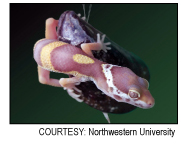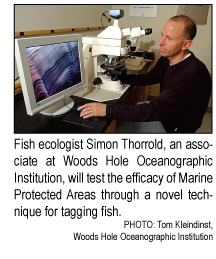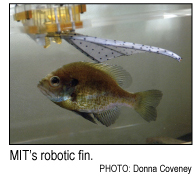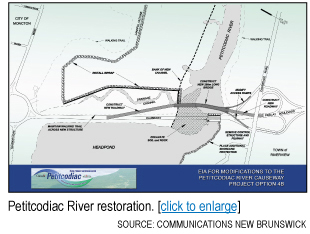|
In the News
[printer firendly version]
Outside the Gulf
 Water
is the enemy of most glue, but scientists at Northwestern
University in Illinois have married the sticking properties
of the terrestrial gecko and the underwater mussel in a new synthetic
adhesive called “geckel.” Geckos can
scurry up vertical surfaces and move upside down thanks to a
substance on their feet that acts much like a sticky note. But
underwater, that ability to stick is reduced dramatically. Mussels
are well known for their sticking ability underwater. Geckel
works both in air and water. The scientists published their work
in the July 19 issue of Nature. The researchers envision the
substance being used to replace wound sutures and as a water-resistant
adhesive for bandages. [more information] Water
is the enemy of most glue, but scientists at Northwestern
University in Illinois have married the sticking properties
of the terrestrial gecko and the underwater mussel in a new synthetic
adhesive called “geckel.” Geckos can
scurry up vertical surfaces and move upside down thanks to a
substance on their feet that acts much like a sticky note. But
underwater, that ability to stick is reduced dramatically. Mussels
are well known for their sticking ability underwater. Geckel
works both in air and water. The scientists published their work
in the July 19 issue of Nature. The researchers envision the
substance being used to replace wound sutures and as a water-resistant
adhesive for bandages. [more information]
 Marine
Protected Areas (MPAs) are often hailed as a way to
halt serious declines in marine species that have been overfished,
but their effectiveness as a fisheries management tool remains
unclear. Simon Thorrold, a fish ecologist from the Woods
Hole Oceanographic Institution in Massachusetts, has
come up with a novel technique for tagging fish that could test
the success of MPAs. Thorrold and his colleagues plan to use
harmless chemical tags to track the dispersal
of the larvae of coral reef fish in the western Pacific Ocean.
They will focus on grouper and snapper around the Great Barrier
Reef and Papua New Guinea. Through a new technique known as TRAnsgenerational
Isotope Labeling, or TRAIL, the researchers will introduce an
artificial chemical tag into the tissues of mature female fish
just before spawning. That chemical tag is passed to the female’s
offspring and becomes a chemical signature within the ear bones
of the next generation of fish. Researchers can then track the
dispersal of the tagged larvae across reefs and large stretches
of open ocean. This chemical tagging approach has been successfully
tested in limited studies with clownfish and butterflyfish. For
more information see: “Tracking Fish to Save Them” and “Do
Marine Protected Areas Really Work?” Marine
Protected Areas (MPAs) are often hailed as a way to
halt serious declines in marine species that have been overfished,
but their effectiveness as a fisheries management tool remains
unclear. Simon Thorrold, a fish ecologist from the Woods
Hole Oceanographic Institution in Massachusetts, has
come up with a novel technique for tagging fish that could test
the success of MPAs. Thorrold and his colleagues plan to use
harmless chemical tags to track the dispersal
of the larvae of coral reef fish in the western Pacific Ocean.
They will focus on grouper and snapper around the Great Barrier
Reef and Papua New Guinea. Through a new technique known as TRAnsgenerational
Isotope Labeling, or TRAIL, the researchers will introduce an
artificial chemical tag into the tissues of mature female fish
just before spawning. That chemical tag is passed to the female’s
offspring and becomes a chemical signature within the ear bones
of the next generation of fish. Researchers can then track the
dispersal of the tagged larvae across reefs and large stretches
of open ocean. This chemical tagging approach has been successfully
tested in limited studies with clownfish and butterflyfish. For
more information see: “Tracking Fish to Save Them” and “Do
Marine Protected Areas Really Work?”
Sappi Paper to remove dam on Presumpscot
River
Sappi Fine Paper North America
reached a preliminary settlement in July that will enhance fishery
restoration efforts on the Presumpscot River, which runs 25 miles
(40 kilometers) from Sebago Lake to its mouth at Casco Bay in
southern Maine. The agreement is among Sappi and American Rivers
Inc., the Friends of the Presumpscot River, the Maine Department
of Marine Resources and the U.S. Fish and Wildlife Service. A
final settlement is expected by year end.
The preliminary agreement includes
removing all components of the Cumberland Mills Dam, installing
fish lifts at Saccarappa Dam and initiating a trap and truck
program to jump-start the restoration of native sea-run species
throughout the upper watershed. The actions are expected to trigger
fish passage at Mallison Falls, Little Falls and Gambo dams.
The settlement stipulates that
all work on the removal of the Cumberland Mills Dam and all renovations
to the area will be completed and operational by May 2011. Additional
work will include fish lifts at Saccarappa Dam, and at the upriver
dams, as fish return to the river.
“Once a final settlement
agreement is executed, we will have taken a huge step forward
in restoring native fish species to our river. These species
link our rivers and the ocean, and rebuild both ecosystems,”
Dusti Faucher, president of Friends of the Presumpscot River,
said in a statement.
Added Marvin E. Moriarty, Northeast
regional director for the U.S. Fish and Wildlife Service, “With
the proposed settlement agreement, we can look forward to a future
of fish restoration in this watershed, where we have not seen
natural fish passage for more than 250 years.”
Currently Sappi provides minimum
flows for fisheries at four Sappi dams: Eel Weir, Dundee, Gambo
and Mallison Falls. These minimum flows are provided to improve
the fisheries for trout and other species on the Presumpscot
River. [more information] and [river facts]
MIT builds robotic fin for submersible
vehicles
Inspired by the efficient swimming
motion of the bluegill sunfish, researchers at the Massachusetts
Institute of Technology (MIT) are building a mechanical fin that
could one day propel robotic submersibles or autonomous underwater
vehicles (AUVs). Those vehicles perform functions from mapping
the ocean floor to surveying shipwrecks.
 The
MIT team hopes to create a more maneuverable, propeller-less
underwater robot better suited to tasks such as sweeping mines
and inspecting harbors by mimicking the action of the bluegill
sunfish. The
MIT team hopes to create a more maneuverable, propeller-less
underwater robot better suited to tasks such as sweeping mines
and inspecting harbors by mimicking the action of the bluegill
sunfish.
“If we could produce AUVs
that can hover and turn and store energy and do all the things
a fish does, they’ll be much better than the remotely operated
vehicles we have now,” James Tangorra, an MIT postdoctoral
associate working on the project, said in a statement.
The researchers chose to copy
the bluegill sunfish because its distinctive swimming motion
results in a constant forward thrust with no backward drag. In
contrast, a human performing the breaststroke experiences drag
during the recovery phase of the stroke.
Tangorra and his colleagues at
MIT have broken down the fin movement of the bluegill sunfish
into 19 components and analyzed which ones are critical to achieving
the fish’s powerful forward thrust.
“We don’t want to replicate
exactly what nature does,” said Tangorra. “We want
to figure out what parts are important for propulsion and copy
those.” So far, the team has built several prototypes that
successfully mimic the sunfish fin. They reported the successful
testing of their most recent fin, which is made of a cutting-edge
thin, flexible material that conducts electricity, in the June
issue of the Bioinspiration & Biomimetics journal.
The fin can replicate two motions the researchers identified
as critical to the propulsion of the sunfish fin: the forward
sweep of the fins and the simultaneous cupping of the upper and
lower edges of the fin.
When an electric current is run
across the base of the experimental fin, it sweeps forward, just
like a sunfish fin. By changing the direction of the electric
current, the researchers can make the fin curl forward at the
upper and lower edges. But it has been a challenge to make the
fin sweep and curl at the same time. Placing Mylar polyester
film strips along the fins to restrict their movement to the
desired direction has proven successful. The team continues to
seek alternatives. [more information]
New Brunswick to restore Petitcodiac
River
The Petitcodiac River in southern
New Brunswick will be restored to a major portion of what it
was before a causeway, or a raised road above water, was installed
across the river in 1968, province representatives said in August.
Supply and Services Minister Roly MacIntyre said the province
prefers to replace the Petitcodiac River Causeway with a 280-meter
(919-foot) bridge costing about C$68 million (US$64 million).
“It offers the most positive environmental benefits for
the river,” he said in a statement. “The next step
is to secure a federal/provincial funding agreement.”
 The
preferred option includes permanently opening the gates to allow
fish passage and constructing the new bridge immediately downstream
of the existing bridge. Once the new bridge is completed, the
existing gates structure will be removed to allow for an eventual
river opening of between 72 meters and 225 meters (246 feet and
738 feet) wide. The
preferred option includes permanently opening the gates to allow
fish passage and constructing the new bridge immediately downstream
of the existing bridge. Once the new bridge is completed, the
existing gates structure will be removed to allow for an eventual
river opening of between 72 meters and 225 meters (246 feet and
738 feet) wide.
Subject to a partnership agreement,
the work will be carried out in three phases: two years for planning
and site preparation; two years for opening the gates and environmental
monitoring of the river; and three to four years for construction
of the new bridge, depending on funding support and seasonal
weather conditions.
The Petitcodiac River restoration
is environmentally sensitive and must be carried out according
to the conditions set by the provincial Department of Environment.
Before the gates can open, planning, remediation work and site
preparation has to be done to prevent erosion along the river.
Once the gates are open, the seasonal response must be monitored
for two annual cycles as the river, fish populations and the
surrounding habitat adjust to the change.
The Atlantic Salmon Federation
(ASF) and the New Brunswick Salmon Council (NBSC) commended the
move by the province. “While this was a difficult decision
for the province, it is certainly the only environmentally correct
decision,” said Patricia Edwards, ASF’s regional director
for New Brunswick.
In a statement, the ASF and NBSC
said that since its construction in 1968, the Petitcodiac causeway
and its various fishways have contravened the Federal Fisheries
Act by restricting or eliminating passage of all fish species.
Countless efforts over the past four decades to improve the fishways
at the causeway failed to provide adequate fish passage for any
species, including the Atlantic salmon.
Prior to 1968, the two groups
said the Petitcodiac River supported a run of 2,000 to 3,000
salmon annually, but after the causeway was completed the Petitcodiac
run dwindled to mere hundreds of salmon. This decline preceded
the precipitous crash of Inner Bay of Fundy (IBoF) salmon stocks.
Those salmon are now listed as “endangered” under the
Federal Species at Risk Act.
“While we are not suggesting
that the causeway was the principal cause for the decline of
IBoF salmon stocks as a whole, it definitely contributed greatly
to the species decline in the Petitcodiac River,” said Gary
Spencer, president of the NBSC. “As long as the causeway
remains in place, salmon cannot ascend the river regardless of
how strong the stocks are. The sooner the proposed bridge is
in place and the causeway and its gate and fishway structures
are dismantled, the sooner we can start restoring wild Atlantic
salmon populations to their natural range in the Petitcodiac.”
[more
information] and [news]
New Brunswick, Nova Scotia to jointly
study Fundy tides
New Brunswick
and Nova Scotia are collaborating to study tidal energy in the
Bay of Fundy. The two provinces will work to complete Strategic
Environmental Assessments (SEA) of the Bay of Fundy before developing
tidal energy policies.
The SEA
will consist of two main parts: an Environmental and Socio-economic
Impact Assessment Report and extensive stakeholder feedback and
consultation.
The assessment
will provide a better indication of where potential tidal energy
sites could be located and any opportunities and constraints
that may exist.
“This
is an important step forward in developing future tidal projects
which could benefit both of our provinces,” New Brunswick
Energy Minister Jack Keir said in a statement.
Last year,
both New Brunswick and Nova Scotia participated in a tidal energy
study conducted by the Electric Power Research Institute, which
provided analysis and identified approximate megawatt potential
for each province. The new study will go into greater detail
on site-specific issues. [more information]
|
![]()
